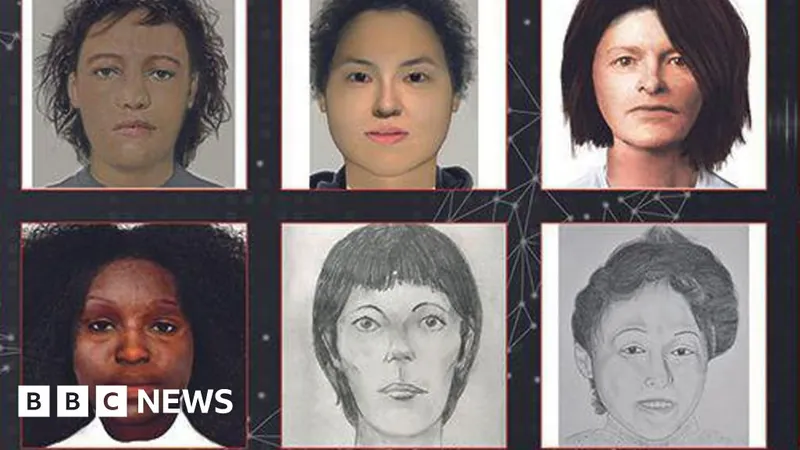
Urgent Call for Public Help in Unsolved Murders of Women Across Europe
2024-10-08
Author: Chun
Introduction
In a haunting reminder of unsolved tragedies, Interpol has launched a renewed appeal for public assistance in the identification of women whose murders remain cold cases. Among the numerous victims is a teenage girl found deceased in western France over four decades ago. The chilling case is one of 46 cold cases the European police are now prioritizing as part of the continuing Operation Identify Me campaign.
Details of the Case
The girl was discovered in 1982, buried beneath a pile of leaves near Le Cellier, accompanied only by a pair of red shoes, two beaded necklaces, and a British 10p coin. These sparse clues hint at her possible British origins or at least a connection to Britain prior to her tragic end. However, investigators have not elaborated on the specifics of her death to prevent false claims from individuals attempting to cover their tracks.
Detective's Statement
Detective Franc Dannerolle, reflecting on the scene where the girl was located, lamented, “She was disposed of like garbage, with no respect or care for her life.” Unfortunately, the lack of physical evidence complicates efforts to connect her DNA with potential family members. Dannerolle stressed, “If we manage to find them, it could be possible to work on her DNA to have a link with the family.”
Objective of the Campaign
The initiative aims not just to solve these murders, but to bring closure to the victim's families and deliver justice to those who suffered. Jürgen Stock, Interpol's Secretary-General, emphasized the importance of every detail, urging the public that 'the smallest detail could help uncover the truth.'
Significance of Operation Identify Me Campaign
The Operation Identify Me campaign marks a significant shift for Interpol, as it publicly shares 'black notices' detailing the identities of unknown bodies—a method previously kept within the confines of police networks. The current stage of this campaign spans multiple countries including the Netherlands, Germany, Belgium, France, Italy, and Spain, with time running out for many victims, especially those believed to be between the ages of 15 and 30.
Trends in Unidentified Victims
Dr. Susan Hitchin, who oversees Interpol’s DNA unit, commented on the alarming trend of unidentified victims. She noted how open borders and global migration increase the number of people reported missing outside their home countries, leading to what she described as a 'double injustice.' These women endure violence and, in death, remain nameless.
Outreach Efforts
The campaign has gained traction through targeted social media outreach, encouraging people to come forward, regardless of how insignificant their information might seem. In an innovative twist, Interpol has also engaged celebrities to help amplify the call for assistance on behalf of these unknown victims.
Another Case: Wassenaar, Netherlands
Another perplexing case highlighted by Interpol involves a woman found in Wassenaar, Netherlands, nearly two decades ago. Her body was discovered in sand dunes, raising concerns about what circumstances led to her end. Detective Sandra Baasbank, who was the first investigator on the scene, recounts the peculiar details of the woman’s appearance, noting her unusual choice of clothing for beachwear and a well-groomed appearance. Forensic investigation indicates she was originally from Eastern Europe and had lived in Western Europe for her last five years—a mystery yet to be resolved.
Conclusion
As the Operation Identify Me initiative unfolds, it shines a powerful light on the unresolved tragedies of countless women, compelling us all to engage in the search for answers. With hope and determination, the international community must strive toward ensuring these victims are no longer left nameless and their stories go untold. The clock is ticking, and every piece of information could be pivotal in uncovering the truths behind these heartbreaking cold cases.





 Brasil (PT)
Brasil (PT)
 Canada (EN)
Canada (EN)
 Chile (ES)
Chile (ES)
 España (ES)
España (ES)
 France (FR)
France (FR)
 Hong Kong (EN)
Hong Kong (EN)
 Italia (IT)
Italia (IT)
 日本 (JA)
日本 (JA)
 Magyarország (HU)
Magyarország (HU)
 Norge (NO)
Norge (NO)
 Polska (PL)
Polska (PL)
 Schweiz (DE)
Schweiz (DE)
 Singapore (EN)
Singapore (EN)
 Sverige (SV)
Sverige (SV)
 Suomi (FI)
Suomi (FI)
 Türkiye (TR)
Türkiye (TR)